matrepr1.0.1
Published
Format matrices and tensors to HTML, string, and LaTeX, with Jupyter integration.
pip install matrepr
Package Downloads
Authors
Project URLs
Requires Python
>=3.7
MatRepr
Make every matrix beautiful.
MatRepr formats matrices and tensors to HTML, string, and LaTeX, with Jupyter integration. See Jupyter notebook for examples.
Brief examples:
from matrepr import mdisplay, mprint
mprint(A) or to_str(A):
<1000×1000, 212345 'float64' elements, coo>
0 1 2 3 4 5 6 7
┌ ┐
0 │ 0.3876 ... │
1 │ 0.5801 0.5085 0.8927 0.629 ... │
2 │ ... │
3 │ 0.7142 ... │
4 │ 0.8631 ... │
5 │ 0.7863 0.1298 0.9918 0.71 0.3444 ... │
6 │ 0.9481 0.9609 ... │
7 │ 0.09361 0.1679 ... │
8 │ 0.4023 ... │
│ : : : : : : : : ... │
└ ┘
mdisplay(A) or to_html(A):

Supports:
- SciPy - sparse matrices and arrays like
csr_matrixandcoo_array - NumPy -
ndarray(demo) - PyTorch - dense and sparse
torch.Tensor(demo) - TensorFlow -
tf.Tensorandtf.SparseTensor(demo) - Python-graphblas -
gb.Matrixandgb.Vector(demo) - PyData/Sparse -
COO,DOK,GCXS(demo) list,tuple, including multi-dimensional and ragged
Features:
- Jupyter extension to format matrices in cell outputs.
- Configurable float precision or format string.
- Toggle row and column indices or set your own labels.
- Nested sub-matrices of any supported type, including mixing packages.
- Toggle matrix description or set your own title.
- String output can optionally autodetect terminal width.
- Methods to directly display a matrix (
mprint,mdisplayfor Jupyter) - Methods to convert to string (
to_html,to_latex,to_str). - Configurable per method call or set defaults with
matrepr.params. - A
__repr__monkey patch to format matrices in the Python shell. - Fast.
Install:
pip install matrepr
or
conda install matrepr
More Examples
HTML
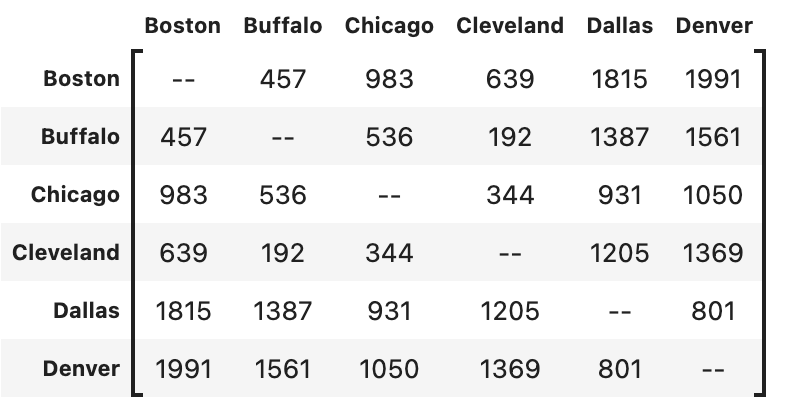
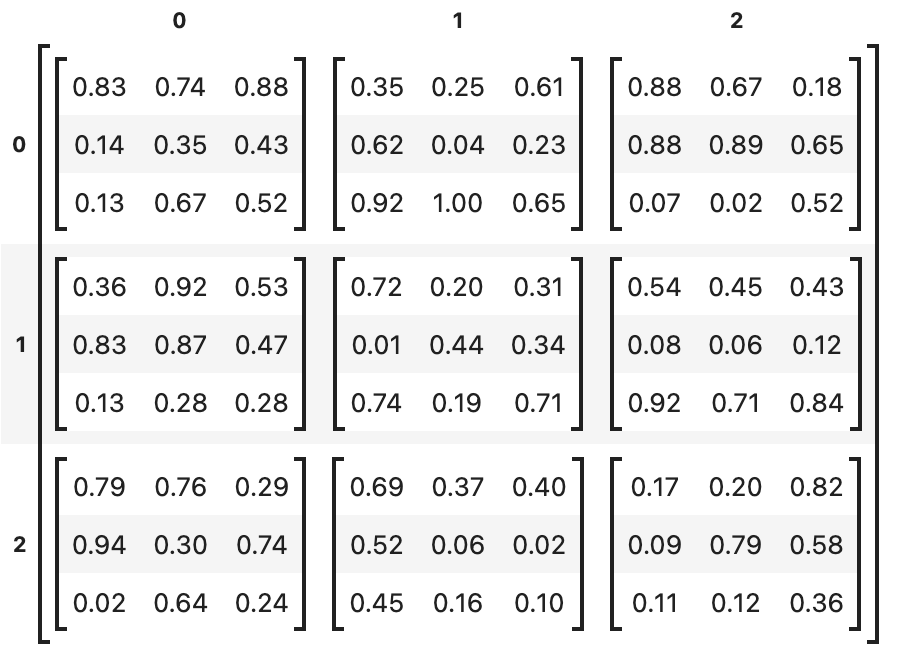
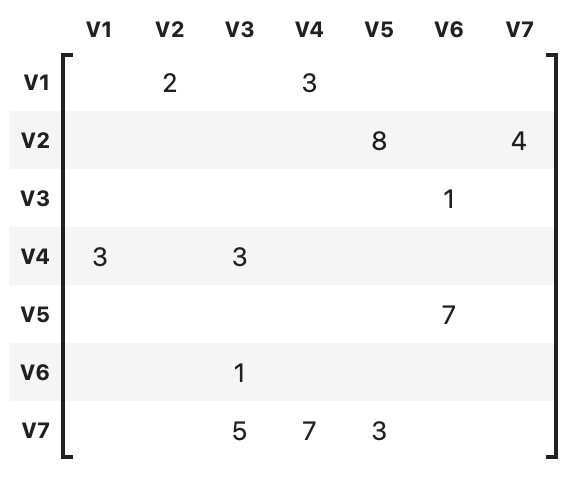
mdisplay(A), to_html(A)
or simply A with Jupyter extension %load_ext matrepr
LaTeX

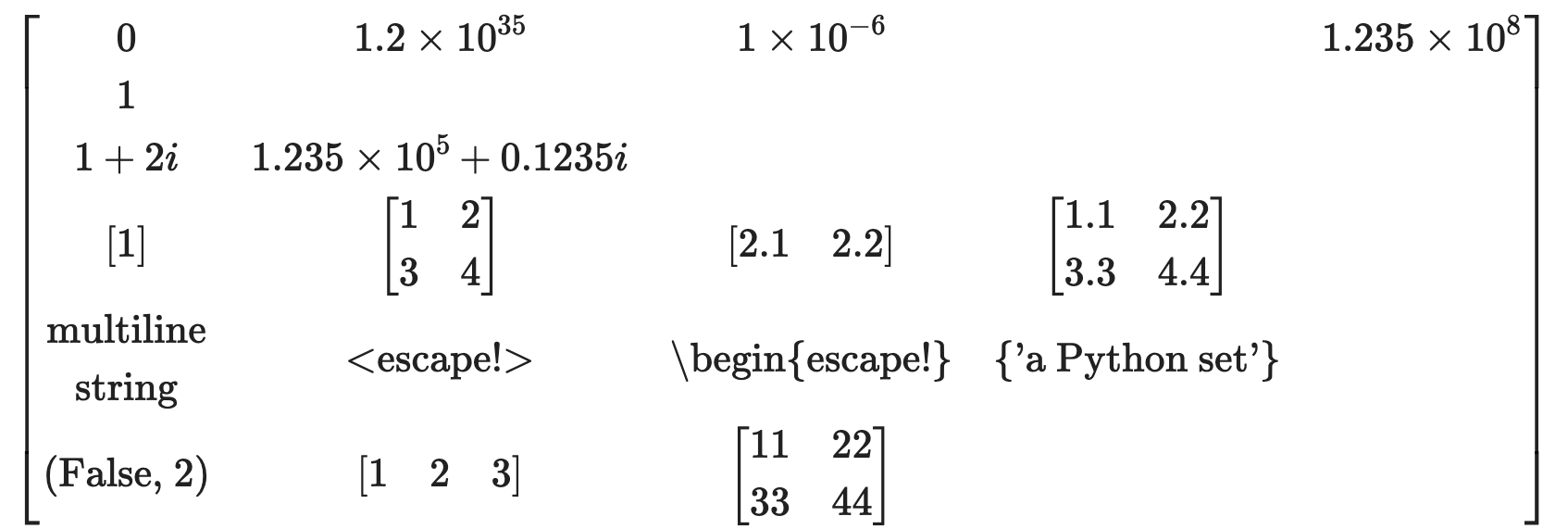
mdisplay(A, 'latex'), to_latex(A)
or simply A with Jupyter extension %load_ext matrepr.latex
Jupyter Extension
MatRepr's Jupyter extension registers with Jupyter's formatter to format supported matrices with MatRepr. Simply:
%load_ext matrepr
Or if you prefer LaTeX:
%load_ext matrepr.latex
Example:
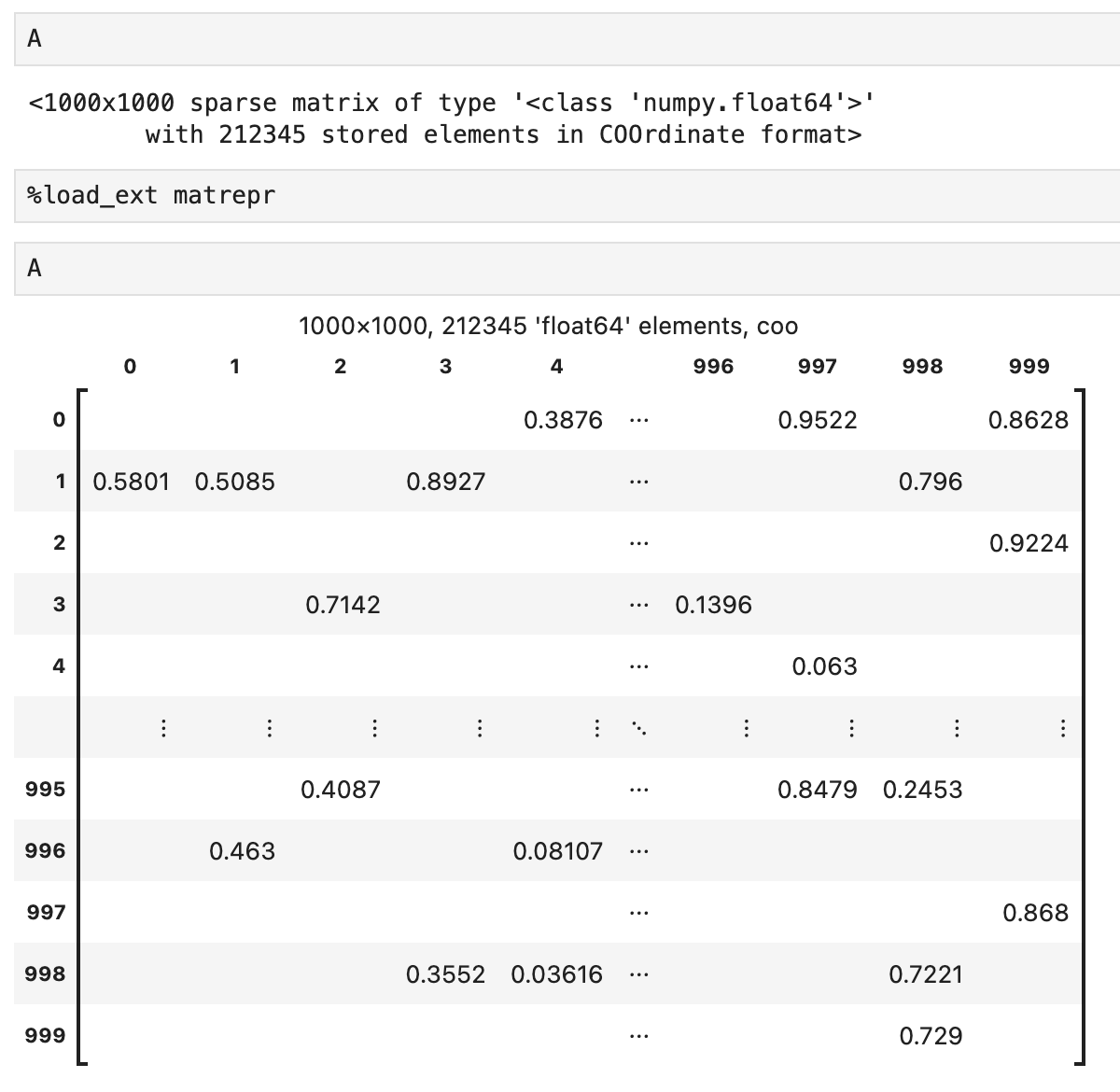
Methods
to_str(A): FormatAas a text string.to_html(A): FormatAas a plain or notebook-styled HTML table. Returns a string.to_latex(A): FormatAas a LaTeX matrix. Returns a string.mprint(A): printAas a string to stdout.mdisplay(A): Displays the output ofto_html,to_latex, orto_strin Jupyter.
Note: For Spy plots see MatSpy.
Arguments
All methods take the same arguments. Apart from the matrix itself:
title: string label. IfTrue, then a matrix description is auto generated that contains matrix shape, number and type of nonzeros, etc.indices: Whether to show matrix indices.max_rows,max_rows: size of table. Matrices larger than this are truncated with ellipses.precision: floating-point precisionnum_after_dots: How many rows/columns to show from the end of the matrix if the entire matrix does not fit.fill_value: Value to fill empty cells.
Overriding defaults
matrepr.params contains the default values for all arguments.
For example, to always disable the title, disable indices, and only show the top-left part of the matrix:
matrepr.params.title = False
matrepr.params.indices = False
matrepr.params.num_after_dots = 0
Interactive Python: Monkey Patching __repr__
The interactive Python REPL does not have a nice way to register a formatter.
We can monkey patch a __repl__ method into supported matrix classes for a similar effect.
This is implemented in the matrepr.patch module. Simply import the patch you want:
import matrepr.patch.scipyimport matrepr.patch.graphblasimport matrepr.patch.sparse
Example:
>>> a = scipy.sparse.random(4, 4, density=0.5)
>>> a
<4x4 sparse matrix of type '<class 'numpy.float64'>'
with 8 stored elements in COOrdinate format>
>>> import matrepr.patch.scipy
>>> a
<4×4, 8 'float64' elements, coo>
0 1 2 3
┌ ┐
0 │ 0.6536 0.008388 0.6564 │
1 │ │
2 │ 0.2987 0.8098 │
3 │ 0.1064 0.9613 0.7477 │
└ ┘
Edge Cases
MatRepr gracefully handles:
- multiple elements with the same coordinates (i.e. duplicates)
- nested matrices
- complex values
- string values (including multiline)
- LaTeX scientific notation as $
\times 10^{power}$
See demo-edgecases notebook for more.
How does it work?
Each package that MatRepr supports implements two classes:
Driver: Declares what types are supported and supplies an adapter.get_supported_types: This declares what types are supported, as strings to avoid unnecessary imports.adapt(A): Returns aMatrixAdapterfor a matrix that this driver supports.
- Implement any of these
MatrixAdapterclasses:MatrixAdapterRow: for structs able to efficiently read a selected row.MatrixAdapterCol: for structs able to efficiently read a selected column.MatrixAdapterCoo: for structs able to extract a portion of the matrix as tuples.
See matrepr.adapters module for details.
You may use matspy.register_driver to register a Driver for your own matrix class.
